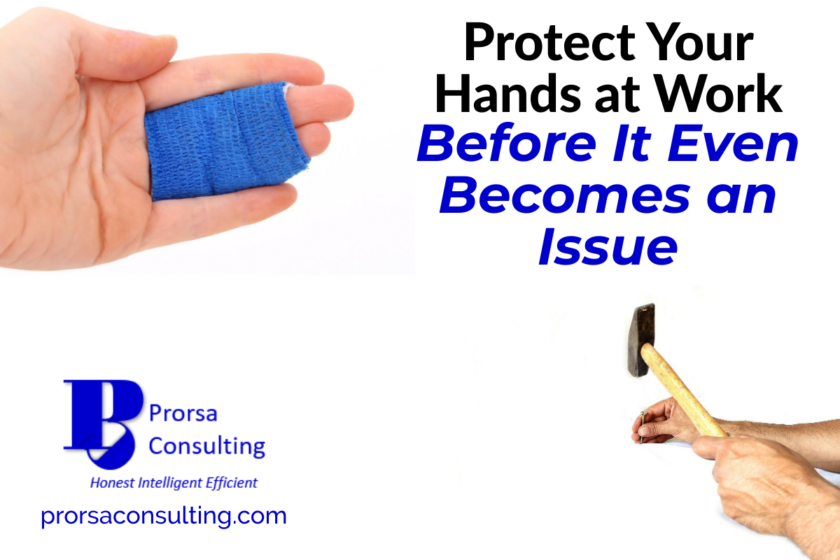Protect Your Hands at Work Before It Even Becomes an Issue
By : Admin -

Steps to protect your hands at work are not the stuff of rocket science.
Yet, the Bureau of Labor Statistics reports that 123,990 nonfatal hand injuries requiring days away from work occurred in the workplace during 2018.
So, if preventing hand injuries is not hard, why are so many people continuing to hurt their hands at work?
The answer . . . ignorance or inattention to the basics.
Robust hand safety management entails educating and reinforcing the basics with workers.
Keep reading for some excellent information to help safeguard everyone’s hand from injury while in the workplace.
Disclaimer: Please be aware that this blog post may contain affiliate links and any purchases made through such links will result in a small commission for Prorsa Consulting (at no extra cost to you). Feel free to visit our Disclosure of Material Connection page for more information.
Protect Your Hands at Work – Common Injuries
You have to know the risks of inaction to drive home the need for any change in behavior.
With injuries, this usually entails creating awareness around the types of physical harm associated with unsafe actions.
So, what types of hand injuries commonly occur in the workplace?
- Abrasions and lacerations – Characterized by a tear or cut in the skin. They can provide entry into the body for microbes, which can cause infection. In severe cases, blood loss can be significant.
- Sprains and strains – Depicted by injury to a ligament (sprains) or tendon/muscle damage (strains). They can take several weeks to fully heal. Additionally, recurring longer-term pain and inflexibility can result if not managed properly.
- Contusions – Occurs when bleeding happens under the skin’s surface and is often associated with a dark color at the site of injury (a bruise). The pain can restrict mobility and use while healing.
- Fractures – Indicated by broken bones due to acute trauma or overuse. Severe pain, swelling, and stiffness, especially with movement, are common symptoms. The range of motion is often restricted during the healing process.

Image by Markus Spiske at Unsplash.com.
- Amputation – Depicted by the severing of a finger, thumb, or entire hand. Notwithstanding the loss of the extremity, blood loss and infection can also become major concerns. This type of injury can leave the individual permanently disabled.
- Impalements – Characterized by objects that penetrate and remain embedded in the hand. Depending on the severity, immediate blood loss may be an issue and surgical removal may be warranted. Infection is always a concern even with smaller impaled objects, such as splinters.
- Repetitive Stress Injuries – Depicted by pain, tingling, numbness, or swelling which usually increases in intensity over time from repeated overexertion or overuse of the affected tissues. When left untreated, permanent damage can occur, leading to loss of use.
- Burns – Indicated by skin damage and cell death caused by contact with heat, sunlight, electricity, other radiation, or chemicals. The level of penetration of damage, intensity, and exposure time often dictate severity. Burns can be accompanied by severe pain, risk of infection, and skin loss in severe cases.
Protect Your Hands at Work – Common Injury-causing Activities
Knowing the common injuries in the workplace constitutes only one part of hand safety awareness basics.
To start properly addressing injury prevention, employees also must know what activities potentially put them at risk for a hand injury.
The truth is just about any task can increase the chances for hand injury if you are not being attentive.
However, the emphasis should be placed on the following major activity groups to enhance prevention efforts:
- Hand tool use – tools in poor condition or possessing blades (box cutters, scissors, knives, screwdrivers) can easily contribute to hand lacerations or impalements.
- Tasks around moving parts – working close to pinch points, conveyors, motors, presses, etc. can heighten the potential for injury. Even normally stationary objects like doors can harm when in motion.
- Material handling – objects like broken glass, wood, nails, chemicals, and even paper can cause injury to the hands when not managed properly.
- Repetitive motion – job duties like typing, sewing, assembly line work, handiwork, and landscaping can place incredible stress on the hands over time as the same muscles and nerves are used again and again.
- Tasks around heat sources – lighting, process equipment, lab equipment, and appliances may possess hot surfaces, increasing the potential for burns.
Protect Your Hands at Work – Prevention and Protection
You’ve been armed with a basic knowledge of the common hand injury types and injury-causing activities.
To finish out the basics’ triangle, we must talk about the prevention and protection measures associated with hand safety at work.
Hence, what do you need to know to prevent and protect from hand injuries?
As is commonplace in injury prevention, you should start with the hierarchy of controls.
The hierarchy of controls levels are provided below in the order each should be considered:
- Elimination – for example, automating a cutting task so no hazard exposure risk exists for workers.
- Substitution – e., replacing metal box cutter blades with micro-ceramic ones that will not cut the skin.
- Engineering controls – such as additional guarding around a product conveyor to protect hands from injury.
- Administrative controls – like, increasing hand safety awareness efforts (we will talk a little more about training in a moment), signage, and standardized work practices.
- Personal Protective Equipment (PPE) – for instance, offering a Kevlar glove choice to workers who perform cutting tasks.
Let’s take a moment to expand on training for hand safety at work.

Image by Niek Verlaan at Pixabay.com.
Hand safety training presents an excellent means to address the knowledge gaps and counterproductive mindsets that can lead to a hand injury.
When workers have hand safety awareness gaps, the focus should be on the tasks and areas where injuries are most common.
The controls instituted to protect hands during work should also receive great emphasis.
This includes practices and the standard operating procedures established for hand safety at work.
Counterproductive mindsets can be formed out of our ability to not fully appreciate our hands until the worse happens.
Some individuals can easily believe they will always have their hands exactly as they are today because it has always been so.
Alternatively, others may fall into the trap of thinking that their hands are not in any major line of fire, so there’s little need for worry or extra attention.
In these cases, training needs to work to dispels these and similar lines of thinking.
This can be done through:
- Explanation of the why’s instead of just the what’s and how’s – Adults especially need convincing to take steps toward proper hand safety; detailing the reasons why certain actions are important help to convince.
- Storytelling to stress the main point – Humans learn their best lessons through experience, but storytelling comes in a close second. Stories make the lessons real and help illustrate valuable information for hand safety at work in a more pleasing fashion.
- Consistent reinforcement – Training does not end with receipt of a certificate. Toolbox talks, observations, and safety moments provide avenues to continue the hand safety conversation outside of the classroom.
Other Posts to Help Protect Your Hands at Work
Robust Personal Risk Assessment in 4 Powerful Acts
Performing a Job Hazard Analysis: Your Powerful Weapon to Prevent Workplace Injuries
Concluding Thoughts
A protective hand safety awareness program is a must-have for strong workplace safety.
Our hands provide the means for us to connect with others and experience the world.
So, protecting your hands at work benefits not only yourself individually, but every life you have the potential to impact.
We encourage your feedback on this blog. Be sure to like and/or share below. You can also provide us with feedback via our Contact Us page.
Don’t forget to follow Prorsa on LinkedIn, Pinterest, and Twitter.
Prorsa Consulting works with small manufacturers who are underperforming in environmental and safety compliance to help them achieve their improvement goals.
How would you like to have access to additional, exclusive EHS updates and info from Prorsa Consulting? Just signup for the Prorsa Consulting Newsletter below. You’ll get access to the Free Resources area and all the tools, templates, and presentations in the library. Get your free subscription today!





